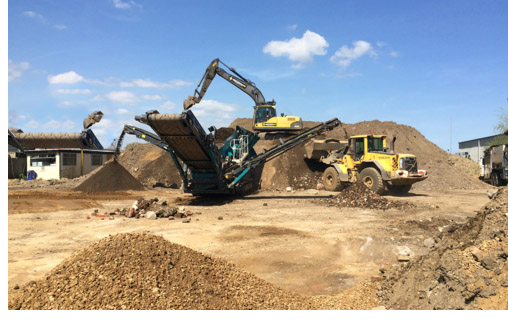
Fine aggregates are non-reactive materials. Like sand, gravel, or crushed stones which are one of the concrete constituent mixtures besides water and Portland cement.
Native Weybridge aggregate is often either quarried or won from a borrowed ditch, riverbed, lake, or sea bed. Stone aggregate is made by use of quarry rock, boulders, cobbles, or large-size gravels. Recycle concrete is a suitable material, obtained from concrete waste materials and stockpiles. It’s used sufficiently for the construction of granular sub-bases, soil cement, and new concrete.
Pre-treatment of Aggregates by Using a Benefaction Process
After harvesting, aggregate is processed. It is conveyed to the washing section where they are crushed, screened, and washed to the required level of cleanliness and size. To improve the quality of the concentrate, a benefaction process like jigging or heavy media separation can be employed. Again, the aggregates are handled and stored. In such a manner that allows the prevention of segregation and degradation as well as contamination.
Aggregates have a significant effect on the various traits of freshly mixed and hardened concrete, the proportions of the concrete, and the economy. Hence, the process of selection of aggregates also gains significance.
Although some variation in aggregate properties is expected, characteristics include:
- Grading
- Durability
- The shape of the particle along with the surface characteristics
- Wearing and friction.
- Weights and voids Today, the significance of unit weights and voids is as follows It is important to note that the maturity of concrete mainly depends on unit weights and voids.
- Absorption and surface moisture armed
The Impact of the Particle Size on the Grading of Aggregate and Concrete
The concept of grading therefore comes with the definition of the extent of particle-size distribution of aggregate. Maximum and minimum grading are state. These characteristics impact the quantity of the aggregate also cement, water workability, pumpability, and durability of concrete. That is, if the water-cement ratio is well selected, there is a considerable variation. It is tolerable in grading without much effect on strength.
So, the particle size distribution of gap-graded aggregate will see one or more particle sizes of the aggregate missing in the size distribution continuum. Another advantage gained from gap-graded aggregate is to acquire uniform textures in exposed aggregate concrete. A very stringent measure should be observed when conducting the mix proportions to help avoid segregation.
Shape and Size Matter
It should be noted that it is the shape and roughness of particles that affect the characteristics of concrete. At the time of slump more than the characteristics of hardening concrete. So, when the particle is rough-textured, angular, and elongated, more water is needed to make workable concrete than when the aggregate is smooth, rounded compact. This leads to the change of the cement content to try and maintain the precise water-cement ratio. In general, flat and elongate particles are use sparingly or not at all.
They are use in the amount of up to 15 percent of the total of the aggregate. The unit weight determines the number of volumes that graded aggregate and voids between them will take in the concrete.
Types of Aggregates
Aggregates fall into three types base on where the minerals are sourced from. Categorized base on whether the material came from a natural source, or has been recycled. These consist of natural sand, natural gravels, crushed rock, type 1 sub-base, recycled asphalt, crushed concrete and type 6f2 sub-base. The specifications frequently use for aggregate in the highways and construction in the UK are Type 1 derive from quarries. Type 6F2 and Type 6F5 derive primarily from Sand and gravel pits.
Natural Aggregates
These are the Weybridge aggregates that are derive from the natural deposits of rock which may be mine, or drag from underwater and which can use with little processing like crushing washing and sorting according to size. This group includes crushed rock, sand and gravel which are use as base courses in pavements, formation fill, or as materials for a particular purpose.
Manufactured Aggregates
These are made through industrial processes and are commonly secondary materials, which means that the item being manufacture is mineral material that is subject to change in one form or another and may involve heat or other treatments. Some of these aggregate products are; Iron and steel slags, and ash.
Recycled aggregates
These produce from the reconditioning of materials that use in construction earlier. Some examples include, Construction and demolition waste such as rubble, used railway track stones, and reclaimed asphalt from road construction projects that involved repaving of the existing roads.